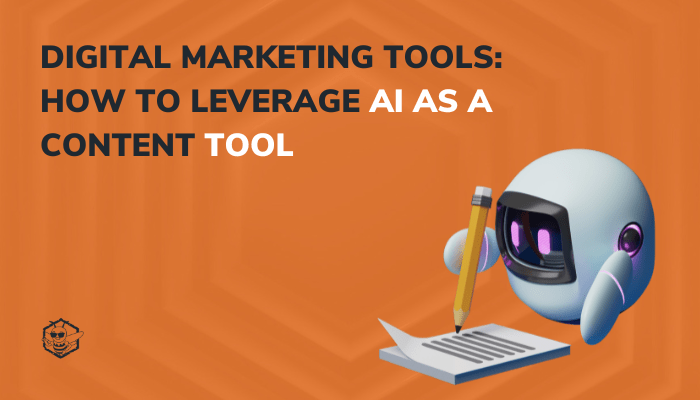Now more than ever before, artificial intelligence (AI) is transforming the way businesses operate, including how they approach content creation. The question isn’t whether AI has a place in content creation; rather, it’s about how we can use AI to create a more effective content strategy. The key here is understanding that AI is here to augment our human capabilities, not replace them.
Understanding AI’s Role in Your Content Strategy
The first step in harnessing the power of AI is understanding where it fits within your content creation strategy. AI can’t fully replace humans. But it can be an invaluable tool that enhances the efficiency of your content production process, provides rich insights to guide your strategy, and offers you the freedom to let your team focus on strategy and innovation. AI is like a powerful engine, revving up your content production line and powering it to run more smoothly and effectively.
Master the Art of AI-Prompting
Artificial intelligence in content creation is only as good as the instructions we give it. The pivotal phase of this process often begins with a ‘prompt,’ a particular task or question you propose to the AI. This could range from crafting a blog post on “The benefits of using AI in content marketing” to constructing an email campaign for a product unveiling. Precision and detail in your prompts yield the most valuable AI-generated content. Making AI work to your advantage demands practice and patience in crafting these prompts.
Now, let’s explore some practical techniques for mastering AI prompting:
1. Visualize Your Desired Output
Before you jump into using an AI tool like ChatGPT, take some time to clearly visualize your desired output. Consider what the end product should look like in terms of structure, length, content, tone, and target audience. Once you have a clear idea, you can compose a prompt that will likely check all your boxes.
2. Craft Specific, Action-oriented Tasks
AI thrives on specificity. Vague instructions might result in AI interpretation that doesn’t match your expectations. So, instead of using a generic term like “rewrite,” consider using more descriptive and action-oriented words like “reimagine,” “expand,” “simplify,” or “modernize.” A slight change in your phrasing can significantly influence the AI’s output.
3. Provide Contextual Clues
To supercharge your prompts, provide as much context as possible. This is like asking a friend to pick up a few things from the store – the more details you provide, the better they’ll fulfill your request. Similarly, providing context to an AI tool, such as the product’s name, its characteristics, or its target audience, helps generate more accurate and compelling responses.
4. Offer Clear Instructions
AI models are like a chef in need of a recipe – they need clear and specific instructions to create a masterpiece. Along with providing a main task, consider also providing AI tools with additional guidance on the content’s structure, format, and tone.
5. Continual Refinement is Key
Crafting the perfect prompt is often an iterative process. If your initial output meets at least 60% of your expectations, then it’s worth refining the existing prompt. If not, it might be best to start anew. Follow-up instructions, such as “Make it sound more conversational” or “Condense this into one paragraph,” can help refine the output.
6. Incorporate Role-Playing
Role-playing can make your prompts more effective. When you ask an AI model to adopt a specific role or function, it assumes a level of expertise that helps generate responses that align with your needs. This can be particularly helpful when you want to consider different perspectives or viewpoints.
7. Use a Chain of Thought
You can provide a series of prompts, each one building on the previous, to guide the AI in a logical sequence. This ‘chain of thought’ approach gives you greater control over the output and works best for tasks that can be broken down into smaller steps.
8. Leverage the Power of Examples
Providing examples to the AI model can significantly enhance your prompts. Examples serve as reference points that help the AI model to emulate a certain style, tone, structure, or format.
Remember, the goal of AI prompting is not to make the AI tool do all the work but to get the AI to work for you. With practice and experience, you can create effective prompts that harness the full potential of AI, helping you streamline your content creation process and deliver high-quality, impactful content.
Unlocking the SEO Potential with AI
There’s an incredible opportunity in using AI to supercharge your SEO efforts. AI can sift through enormous amounts of data in seconds, identifying the most relevant keywords and forecasting future content trends. By leveraging AI in your SEO strategy, you can ensure that your content is not only discoverable but also highly relevant and engaging to your audience.
Putting AI to Work in Content Production
Imagine cutting down the time your team spends on research and initial content drafts. AI can automate these labor-intensive tasks, freeing up your team to spend more time on strategic tasks, like brainstorming innovative content ideas or refining your overall content strategy. However, remember that while AI is a workhorse, it still requires a human’s touch to guide it in creating content that truly resonates with your audience.
AI is not just a buzzword – it’s a transformative tool that can propel your content strategy to new heights. With AI, you can glean deeper insights, streamline your content production, and create more time for your team to focus on crafting strategies that truly move the needle. As we continue to explore and embrace the potential of AI in content marketing, the most successful strategies will strike a perfect balance between leveraging AI and preserving the essential human element.
This content was originally published here.




